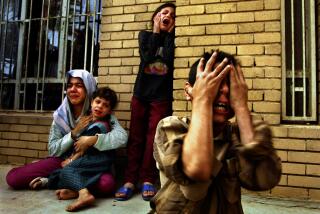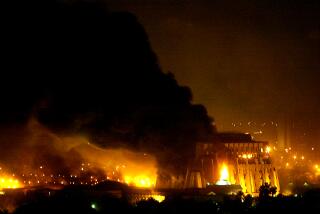Fight for Town Far From Over
TALL AFAR, Iraq — Fighters of all kinds have signed the dusty walls along these narrow streets, laying claim to the ancient city. Like spells, the threats, promises and soldiers’ shorthand are scrawled on the houses of Tall Afar.
On a recent morning, an Iraqi soldier considered his missive.
“The Iraqi Army Is Here,” he finally wrote in flimsy white chalk.
It may be a bit premature for the Iraqi army to claim Tall Afar. This strategically important city on the road to Syria has changed hands more than once in the last 14 months.
In a major offensive last year, U.S. forces swept through Tall Afar, killing about 180 suspected guerrillas. But as the operation ended and U.S. forces withdrew, the city again gradually fell under insurgent control. Guerrillas built a network of sophisticated training centers, teaching Iraqi and foreign fighters how to build bombs and behead prisoners, U.S. commanders say.
By this summer, Shiite Muslim militiamen controlled the police department, and Sunni Muslim extremists controlled schools and mosques.
In September, almost a year to the date after the first offensive, 8,000 U.S. and Iraqi soldiers invaded the city in the largest urban combat operation in Iraq since the siege of Fallouja in November. Thousands of residents fled to makeshift camps in the desert, leaving Tall Afar a ghost town. For several days, missiles rained down on this city and soldiers fought among the ruins. At least 800 suspected insurgents were arrested and 162 others killed.
Now, to prevent insurgents from gaining a foothold in Tall Afar once more, American forces are rebuilding the local security force, repairing the city’s infrastructure and trying to restore sectarian relations, efforts that will be key to an eventual pullout of American forces here, U.S. commanders say.
But that may not be any time soon. After meeting with U.S. Army Col. Christopher Gibson recently, an Iraqi colonel, Sherzad Khadem Hassan, said his soldiers wouldn’t be able to operate independently until they got more equipment.
“We have no armored vehicles or enough weapons to conduct independent operations,” he said. “If you park five of my vehicles in a row, a shot from an AK-47 will penetrate all of them.”
Gibson, commander of the 2nd Battalion, 325th Airborne Infantry Regiment, acknowledged that the Iraqi army in Tall Afar still faced organizational and logistical challenges. But the battle-readiness of the troops, he said, “can be measured in months, not years.”
The police department will be another critical element in reconstructing Tall Afar, said Army Col. H.R. McMaster, commander of the 3rd Armored Cavalry Regiment that controls northwestern Iraq.
Twice dominated by sectarian groups -- first Sunni, then Shiite -- the police department had practically collapsed by September, becoming instead an armed militia. Insurgents took advantage of the bloody tribal and sectarian feuds, and more people were pushed into the ranks of the rebels, say American commanders who have encouraged local recruitment to make the police department representational of the city’s 200,000 residents, who are about 70% Sunni and 30% Shiite.
Because a large part of the insurgency has been local, the police department must be local too, McMaster said.
“They can pull the wool over our eyes,” he said, “but they can’t pull the wool over an Iraqi’s eyes.”
Initially, getting local recruits was slow going. Only three Sunnis showed up during an early recruitment drive in the city, and as a stopgap measure, Sunni police officers were imported from Mosul, about 40 miles east.
Despite a suicide bombing that killed 30 army and police recruits this month in Tall Afar, men are now signing up in droves, and hundreds of trainees are waiting to return from the police academy in Jordan, McMaster said.
“At first, they didn’t want the Iraqi army in their neighborhood but were asking for us,” McMaster said. “Then it became OK that the Iraqi army was there, but they distrusted the police. This takes time.”
To better relations, U.S. soldiers and Iraqi police go on joint patrols, doling out food, water and money to the locals.
On a recent day at Command Operating Base Tombstone, a platoon of paratroopers waited for 10 Iraqi police officers. The mission: to hand out small radios to locals while gathering information on two alleged insurgents. At the appointed hour, only five policemen had shown up. While the 16 Americans waited for the stragglers, Iraqi soldiers and other policemen nearby tried to score the giveaways for themselves.
“No,” Army Lt. Brian Barnett said sternly. “These are for the people.” A police officer approached him, wanting a radio so he wouldn’t be bored during checkpoint duties. “They’re not supposed to listen to the radio or watch TV. They’re supposed to pay attention to the road,” Barnett told a translator.
Almost an hour later, all 10 police officers had finally gathered in the dusty road outside the station. An Iraqi sergeant ran out, demanding a radio for a police colonel. An American soldier muttered a profanity under his breath. “Toss him a radio,” Barnett said, sighing. “I’m not going to argue anymore. Let’s go out and do the mission.”
As the platoon walked farther into the maze of narrow streets, distributing radios with the Iraqi police officers, several members groused about their new mission. During two previous deployments to Iraq -- in Baghdad and in Mosul -- the 2nd Battalion, 325th Airborne Infantry paratroopers’ objective had been “search and destroy.”
“Now we’re shaking hands and kissing babies,” Spc. Paul “Shane” Spicer said.
A boy on crutches hobbled through the rubble of a house that had been obliterated by American missiles. Nearby, a child’s drawing on a wall depicted tanks, helicopters and jet fighters bombing a house.
A family approached the soldiers. Their son was in pain after recent appendicitis. “I’ve had the same operation. Tell him, he can’t lift anything heavy and he can’t walk around too much,” Barnett said before doling out painkillers.
The tablets, Barnett judged, might also prove an antidote against insurgents. He decided to try his luck. Holding up a picture of an alleged insurgent, he asked the ailing teenager, “Do you know this man?”
More to Read
Sign up for Essential California
The most important California stories and recommendations in your inbox every morning.
You may occasionally receive promotional content from the Los Angeles Times.










